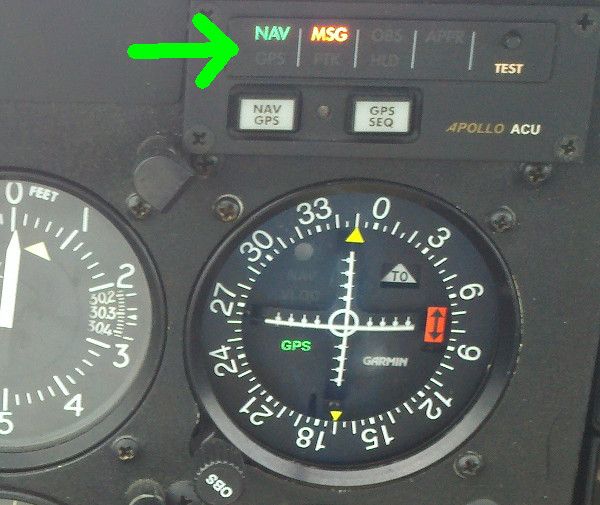My plane has two GPSs. This is not the way I would have designed the panel going in. Typically the planes I've flown have been one aviation GPS unit (which typically has a radio in it) and a communication radio with land-based radio navigation. That gives a certain redundancy; GPS for its nice features and the navigation radio for its.
Up until 10-odd years ago, I suspect my plane had the usual radio-based navigation devices in it. At some point someone installed an Apollo GX-60. The GX60 is a communication radio (but not a NAV radio) and it's an IFR-rated GPS, including being able to do non-precision GPS IFR approaches. It was a very very nice piece of gear for 1999.
At some later point, someone else (I think the guy I bought it from) also put in a Garmin 430W. Like the Apollo, the Garmin is a com radio, it can do IFR en-route and non-precision IFR approaches. Unlke the Apollo, it can use radio navigation both for en-route (VOR) and precision approaches (ILS). The Garmin also has a slightly bigger and color screen, and is just generally more sophisticaed and has more features.
My general intention when buying the plane and when initially flying it was to use the Garmin as my primary guidance and have the Apollo for backup. The Garmin is the nicer GPS, plus several of the club airplanes that I've flown have had a 430 or its big brother the 530, so I'm very familiar with how that family of GPSs operate. The Apollo was new gear to me. My plan was to mostly fly with the Garmin and ignore the Apollo.
However--there's something wrong with the Garmin, it seems. Four times now, it's done a full reboot for no reason that I could discern. It didn't stay powered down at all, just went to the initial startup screen. It happened twice as I was doing my initial training; they tighened the connects, and thought that was it. Then it failed again tens of hours later. I thought perhaps it was one of the memory cards...but now it's failed with the other one.
After the third failure I realized that I really couldn't depend on the Garmin for primary guidance for IFR flying. When it resets the currrentl flight plan gets erased, so if your'e flying IFR if it resets you're suddenly in the clouds and your magenta line is gone. Fortunately, the Apollo can ALSO be used for IFR flight as primary guidance. When I was having the realization about the Garmin, unfortunately, there had been something wrong with the Apollo as well (or so I thought).
Traditional radio navigation instruments typically had guidance in one dimension; they would tell you how far you were from the center of a cerrtain line (typically extending out from the center of a radio beacon). The instrument that shows how far you are from the center of where you want to be and which direction is called a "Course Deviation Indicator" or CDI. GPSs have carried that tradition forward. Aircraft panel-mount GPS units typically have a CDI that tell you how far you are from the center of the intended track.
You can see my two GPSs and their corresponding CDIs in this photo:

The Garmin 430W GPS is on top on the right, marked with the green "A",
and the dotted line goes to its CDI in the upper left. The Apollo is
by the green "B" and its CDI is in the lower left.
Flying down to Florida (to drop off my Mooney instructor) and flying the plane back home, the CDI for the Apollo didn't work. Since I was using the Garmin, I didn't really care. However, once I realized I was going to have to start usin the Apollo for primary guidance, the CDI not working was a problem. Aside from being nice to have, the CDI is REQUIRED to work if you're using that GPS to fly approaches. So without the CDI for the Apollo working correctly, I was looking at having an airplane with no safe legal way to fly IFR.
So I spent a few days grumbling about this and trying to figure out what things to check that weren't working, and what wiring to look at. I was looking at the wiring in an installation manual for the Apollo, when I noticed something I hadn't thought of. The Garmin has its own CDI, made by Garmin. The Garmin product is advanced enough that it assumes that it's the primary guidance in the airplane. However, the Apollo is enough older that it probably doesn't. The CDI wiring for the Apollo goes through an annuciator/selector panel, so that you can have the same CDI reading navigation signals from a radio navigation device (but not at the same time; you have to select one). It occured to me in the middle of the night as I was stewing about this that it was JUST possible that somehow the selector switch had been set to "NAV" rather than "GPS", and so the CDI was fine but since there's no navigation radio in the airplane, the CDI appeared dead because IT HAD NO INPUT.
So the miracle of being an obsessive documentation photographer, I
pulled out my phone and looked at the photos I took of the panel on
the trip home and found this:

Yay! The CDI was broken because I didn't engage it! (Duh.)
So--I spent a good amount of time over the following two weeks, including some ground simulator time and actual flight time getting used to the Apollo GPS. I read the manual voraciously and I'm pretty comfortable with it now. There are definitely things about it that are better than the Garmin interface. But now that I'm confortable with it, I'm fully confident (and legal) in flying IFR with the Apollo GPS as my primary guidance and flying GPS approaches with it.